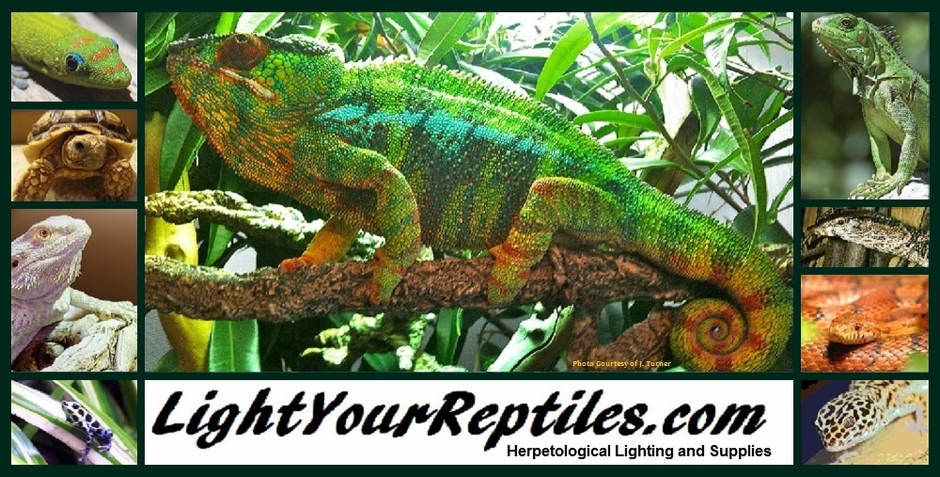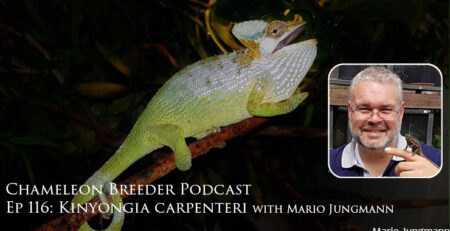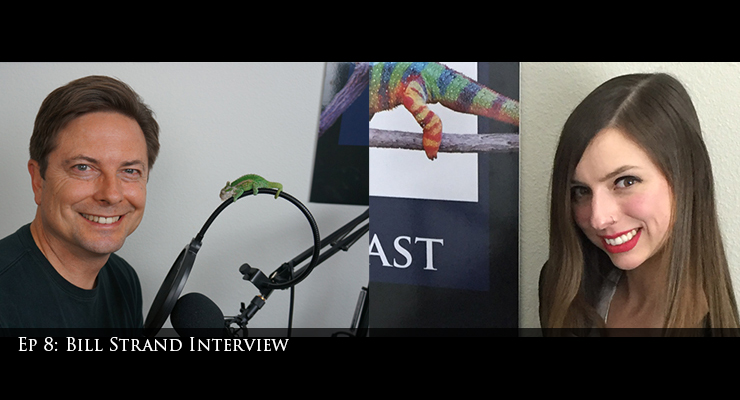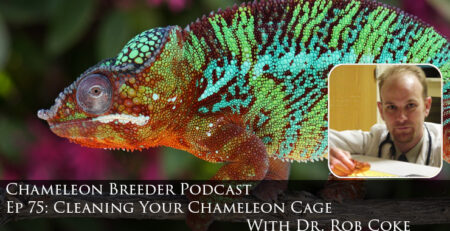Ep 91: Veiled Chameleon Lighting
Chameleons are energized from the sun. To keep them in captivity we must replicate the sun’s light, warmth, and UVB. Today we talk about what Veiled chameleons need from their light source.
SolarMeter 6.5 for measuring UVB
Important! To seriously dial in your UVB, the Solarmeter 6.5 is the tool you need. It measures UV Index which is the the band of wavelengths important for vitamin D3 conversion. You can buy one at the link below
There is a second version that this company puts out that lists the Ferguson Zones on the unit itself. These are the recommended UVI readings for the various reptiles. The electronics are exactly the same as the 6.5, but it has useful charts printed on the device. It is just a matter of preference!
T5 Lights and Fixtures for Veiled Chameleons:
The following is a snapshot from Yemen by Martin Wendsche that shows the heavy fog that is present during the wet season as well as the dense vegetation that the Veiled Chameleon hides in.

The dense vegetation where the Veiled Chameleon lives, by Petr Necas

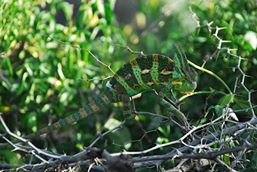


One of the reason why search for chameleons is hard during the day – they hide in dense brush! (Photo courtesy of Petr Necas)
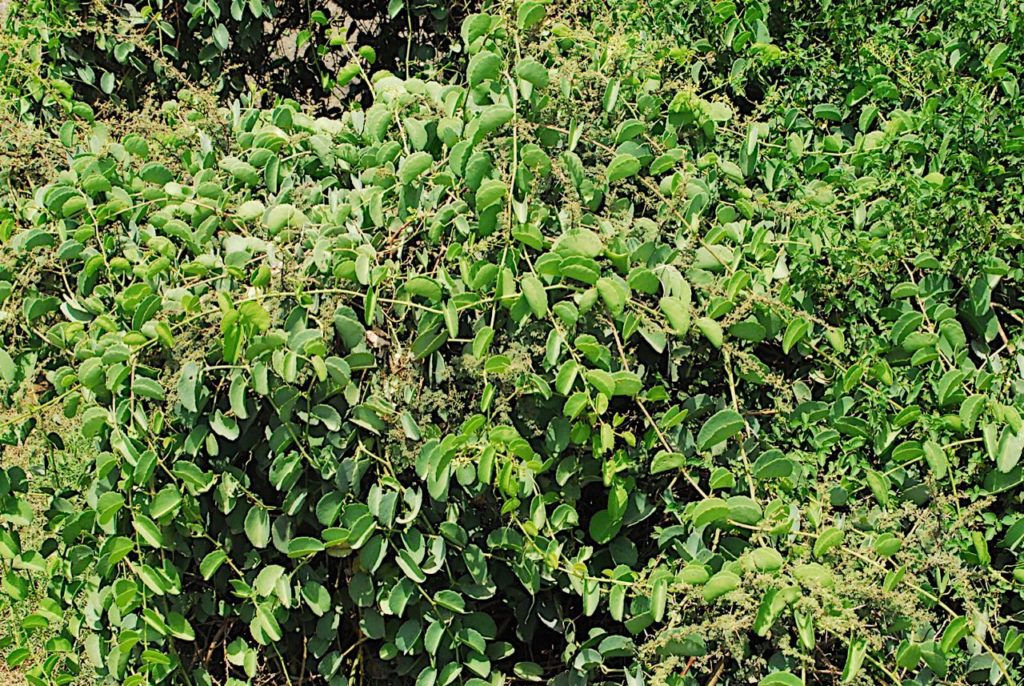
Transcript (more or less)
Veiled Chameleon Lighting Intro:
In this episode we turn our attention to lighting. Veiled chameleons need the same from light as every other species of chameleons – ability to see, warm themselves up, and receive UVB rays. If you remember from last episode, I had the example cage interior split into three levels with the top level being the basking zone. This is the zone where we are simulating the forest’s edge. While the wadis in Yemen, these are the tropical valleys running through the barren surroundings, are not what we would think of as a typical forest, the term “forest edge” is being used in biology to describe the edge between full exposure to the sun on one side and hiding in the shade on the other. We in the chameleon community can adopt this term also. Effectively creating this “forest edge” in our cage gives us all four main gradients: heat, UVB, humidity, and exposure. So our discussion about lighting revolves around an area where a basking branch (or branches) allows the chameleon to be in the proper range of our UVB and heat lamps and then has a defined wall of leaves to where the light area is blocked from going further. Now, considering how hard we have to work to get enough light, heat, and UVB into the cage in the first place and the frustratingly short effective range of all three, this wall of leaves is not strictly necessary to protect them from the heat and UVB like in the wild. But it is important to give them a intuitive place to hide and it is what they naturally look for as part of their daily routine.
Before we get into lighting I want to point out that our technologies are excellent in producing artificial light, but they are pitiful when compared to the wild experience. We are having to take one element – sunlight and we use three different bulbs to give us the same effect. And, we are going to have to understand our tools. Artificial bulbs produce their maximum energy at the surface of the bulb and then it dissipates rather quickly. This is why just moving your hand an inch or so in either direction from an incandescent bulb can be a noticeable difference in heat. That is not the way the sun works! You can stretch your hand as close to the sun as you can reach and it will still be the same temperature and UV index as when it was at your side. Moving one meter closer or ten meters closer to the sun doesn’t practically matter. But with our artificial bulbs, one inch of distance makes a noticeable difference in heat or UVB. So we have to be careful to position the basking branch at a place in the cage where the lights are situated so our chameleon gets enough heat, but not too much; and enough UVB, but not too much. It is our balancing act. And with the bulbs producing dangerously high heat or UVB at the bulb surface, but inadequate energy just 24 inches away it becomes necessary to put some thought into creating the right spot. And, that is why we are here today! Let’s figure out the right balance for veiled chameleons specifically.
Daylight
So let’s start with daylight. And by this I mean light to see. Too many cages have woefully weak lights and look like a cave. Our cages need light. Our cages should have thriving plant life. The best indoors daylight bulbs have been T5 High Output 6500K fluorescent tubes. And I usually use three of these bulbs for my 48” tall cages. I flood my cages with light so the living area is bright and cheerful. Only the wall of leaves gives shade and a darker area. I have used four bulb T8 shop fixtures before. They work, but nothing compares to the T5 High Output bulbs. They may or may not be easy to find. I use www.lightyourreptiles.com and have been happy with that service.
The parameter we will deal with as far as visual lighting goes, is the length of day. Yemen’s daylight hours range from around 11 hours in December to almost 13 hours in June. Length of daylight can be important in species that look for seasonal cues to signal breeding time. As veiled chameleons are designed to hatch and breed within the same season, the lengthening or shortening of the daylight hours probably does not have an effect on calyptratus. I would say we are safe keeping a 12 hour daylight regimen all year. But if you are obsessive about details then, well, I like you and you go with your daylight variation change to match the home country.
UVB
Now we get to a chameleon keeper’s favorite topic, UVB. This is a topic foremost on our minds because Metabolic Bone Disease is a result of not having enough useable calcium in the diet. Vitamin D3 is what makes the calcium in our, and our chameleon’s, diet useable. And we induce the synthesis of Vitamin D3 in ours or the chameleon’s bodies by exposing ourselves to the UVB wavelengths in the sunlight. UVB is what gives us sunburns, but before our skin got to the burning stage, it was using the UVB energy to convert the vitamin D in the body into Vitamin D3. Without the D3 stage, calcium in the diet is reabsorbed, flows through the bloodstream and is uselessly expelled later.
Our chameleon needs calcium for proper metabolism, healthy organ function and to contribute to the forming of hard bones. Without vitamin D3, chameleons get Metabolic Bone Disease which is the same as rickets in humans. In very simple terms, the bones get fragile and break easily . The jaw is rubbery and too soft to grasp prey or even properly eat. The entire MBD process is incredibly painful and leads to slow starvation. So this one is critical to get right.
The first decision we have to make is how intense we need our UVB to be. UVB is measured on the UVI or Ultra Violet Index scale. Long timers will remember the green Solarmeter 6.2 that measures UVB in unit of micro-watts/square centimeter. This is effective, but measures a wider range of wavelengths than the Solar meter 6.5 which was designed to specifically measure the wavelengths that cause Vitamin D transformation into D3. It is convenient that the same energy that converts vitamin D is the same energy that gives us sunburns because the UV Index is used by weather stations around the world to give warnings to people of sunburn danger. This means we have access to some internet information which is much more convenient than to travel around the world and see how long it takes to get a sunburn. Now, as you have heard already, we have to be very careful as to how we use the internet data. That is just a gross magnitude measured by a weather station in a certain area. It is not the conditions that the chameleon lives in. Every animal selects certain microclimates to travel in and out of to maintain certain balances in their lives. What is important to us keepers trying to recreate their living conditions is not to recreate the condition at the weather station, but the group of micro-climate conditions in which the chameleon chooses to live. The weather stations can only tell us the upper or lower bounds of the microclimates we need to discover. Our only way of determining what these micro-climates are is to be there ourselves and observe their behaviors. And this is why I have spent so much time and energy seeking out individuals that have been there and have raised chameleons so they know what I am looking for when I ask my questions.
To start this exploration of the relationship of behavior and the sun I asked Petko what he could tell me about UVB exposure for the calyptratus in the wild.
Petko Dvorak (through translator Alexandra Urbancova) “I have not measured the UV index in Yemen, but I guess that they do not get so high doses of UV as they spend of the time during the day hidden deep in the vegetation in deep shade and the deliberate basking happens, as a rule, when the sun is still rather low. The dominant males might get high doses of UV due to their exposure. My opinion is that they are rather immune to it than they should need it. The reason is that because the other chameleons such as submissive males and females should bask as well which they do not do, obviously.”
Our weather stations give us some pretty high numbers for the UV Index in Yemen. They can hover between ratings of 9 and even 12. This tops the World Health Organization’s chart as “Extreme”. They would rather you say indoors for your own health! Before we recreate this in our cages we need to temper that with some analysis of what the chameleon does with these numbers. If veiled chameleons are basking during the mornings and then hiding during the afternoon then their UV exposure will be greatly reduced. A quick check for Los Angeles today says that the top UVI this afternoon will be 10.7. This isn’t 12, but pretty close. The times that my chameleons bask are from sun rise to 9 AM or so on a sunny day. Of course, temperature plays a key role in basking. So to create a workable model I need to assume a clear day in both areas. Today at 9AM the UVI was 3.3. By 10AM the UVI was 5.8. And I can verify, from keeping Veiled Chameleons outdoors in large heavily planted cages, that they would retreat into the shade on Southern California summer days. As temperatures and UVI are similar between Yemen and the hottest Southern California days we can also gather data from our own observations at home. We just have to be very careful in how we interpret it. Just like the internet weather stations – it is one more piece of data for our puzzle. So it is reasonable to say that calyptratus are done basking before the UVI hits 6. Of course, they still get indirect UVB exposure throughout the day because they do not retreat into a cave, but they do retreat into the dense shade and the UV Index is filtered down even further. And, by the way, this is why it is frustrating to go chameleon hunting during the day. I am including some images in the show notes of the vegetation that calyptratus can be found in Yemen during the wet season. We don’t normally see picture of calyptratus in this vegetation because it is so hard to find them hiding.
At this point let’s ask the question directly and get a breeder’s opinion from Petr Necas. I asked him directly about the significance of UVB and our captive husbandry
Petr:“Look, it is not a black and white area. Again, we need to understand what is natural and normal for them. If you go to Yemen in the dry period, you will see levels which are simply crazy. Even you, as a human, if you walk there in the daytime, you’ll get burned very easily. We need to understand that this is exactly not what they need, but what kills them. On the contrary, in the periods of time when they are young, from the moment when they hatched, until the moment they reached the sexual maturity and almost the full size, Yemen is covered — not Yemen, but exactly these areas where these chameleons live, is actually covered by clouds and mist and fog almost every day, so that the levels of the UV they get are not extreme. They are actually quite low.
Moreover, as you see chameleons — people believe that chameleons are actually animals that love to bask. Chameleons are actually not sun lovers and they use the sun only for heating their bodies to a temperature that they need, to the levels that they need and then, they hide actually from sun. Saying that, of course, I do not say that even in the shade, you do not get decent doses of UV for the chameleon body to adopt.
However, I would really not be too hysteric in providing huge amounts of UV for the chameleons because this is not natural. Once more, for the young ones, there are limited sources and limited levels because of the huge water cover of the valleys that they live in. For the adults, the UV is not so necessary because the extremely high levels actually can contribute to their being killed by the natural conditions there.
I would like even to say one thing more. Looking back with lots of nostalgia to the first years of me keeping the Yemen chameleons in captivity, I have to tell you, they had no UV available in sources like what we have now. We had not linear sources. We did not have the dome sources and so on. We had to come over. I can tell you, I kept chameleons until the 12th generation without any UV source. Saying that, I do not say that you should not use them. We should definitely provide them with UV because it is vital and we know how UV works actually in the physiology of the Vitamin D metabolism and so on and so on.
However, let us really not be too hysterical, providing them extreme doses, because they might be either not necessary or even there might be, in some phases of their life, harmful.”
One question that we chameleon keepers have commonly asked is if chameleons actively regulate their UVB intake or if it is just a byproduct of basking in the morning. Do veiled chameleons seek out UVB when needed? If you set up the lighting as described in this podcast the answer to this question is merely academic. But I do like to ask for opinions from a wide range of sources and I did not want to miss an opportunity to ask Petr his opinion.
Petr:“Well, this is a very spectacular question and there is no real answer which I can give you based on scientific evidence. I can only speculate, and I will now. I doubt it and there is no evidence of it in the science and in the logic that chameleons seek specifically and, I would say even in human terms, deliberately the exposure to UV. I doubt it and I think it is not like that. I think they get the UV like a byproduct of their other behavioral mechanisms, like what you named, while basking.
They, by definition, get UV, direct exposure from the sun rays. It’s not what they seek for. They get it and of course their physiology is in some extent used to it. Same, once they hide in the shade, we cannot say that they are safe from UV exposure at all because of course the light is not shining only in the direction from the sun to the soil. It gets redirected on the molecules of air and on the surface and so on. They get reduced numbers of UV also in the shade.
My strong belief is there is no natural mechanisms how they really regulate and how they seek, or how they fill the deficiency of UVB. It is a byproduct for me of their other behavioral mechanisms that we just currently discussed. “
So what does this mean for our husbandry? First of all, the behavior of exposing themselves to the direct sunlight in the morning and then retreating into the leaves means we have to take a snapshot of that tree edge and recreate it in our vivarium. Thus the “forest Edge” strategy is appropriate for the veiled chameleon. And it is important that you do establish this for the species you get. The Forest edge strategy works for most chameleons, but you would want to re-evaluate your conditions for deep forest species that do not travel to the open canopy.
We have to somehow put together a reasonable UVB level at our basking spot. We have to make sure there is enough UVB so that D3 synthesis can occur. Too little and we get MBD. There is a limit to how much exposure the chameleon can have before their defenses kick in to protect the body. Your chameleon will have some defenses against the burning of UVB. I have anecdotally heard that the body cavity of the males that posture to each other all day to show dominance have a very black peritoneum, which is the sack that surrounds the internal organs. This would be to protect the organs from the UVB. We don’t see this as much in captivity and if this is a sign of excess UVB, I would suggest this is not a bad thing. But veiled chameleons are designed to hide and get away during the afternoon. This is what they do when they don’t have some primal drive to show off regardless of the damage it does to their bodies. ..Not unlike teenage boys I would say. Some of us are lucky we survived to adulthood. So it is not a good thing to over radiate them. There is the added danger in our inside cages that we are able to give them more UVB at a lower temperature. Unlike when the sun peaks over the horizon and the veiled chameleons start basking, when we turn on our lights they come on at full strength. So we are forcing them to receive the full strength of UVB during the whole of their basking time. This is not natural. While we spent many years wishing we could have a powerful enough UVB lamp that we could do away with D3 supplementation, the bulbs these days can be downright dangerous. So, yes, we are at a point where you can give them too much UVB if you are not careful. So where is that danger point? Unfortunately, we don’t know this yet. My personal goal is to find the levels where they can grow healthy without vitamin D3 supplementation. Really, anything beyond this is just stressing the chameleon’s body by forcing it to defend against the damaging UVB rays.
And so, I did an experiment. I knew within the community that a well known keeper had raised and maintained a veiled chameleon under a UVI of 3 without D3 supplementation. That was a perfect starting point as 3 is the estimate I calculated before as to a reasonable magnitude at the time when veileds would start basking. I put a pair of veiled chameleon babies in cages where the one basking spot had a UVI of 3. But, maybe this was on the lower end of what they needed. If this was the lower end then a pair at a higher level should do better. So I put another pair consisting of a brother and a sister to the original pair in an identical cage set-up where the basking area was at UVI 6. I used Arcadia 14% UVB bulbs in single bulb reflectors at adjustable heights so I could get and maintain as close to 3 and 6 at the basking spots during the experiment. I angled the heat lamp to one particular spot and used that as my UVB measuring spot. I reasoned that would be the point they would be when they wanted to bask and this is the time in nature they would get that full level of UVB. Now, let’s get some perspective on this. I need to be realistic about what I was measuring. I was not measuring the affect of UVI 3 vs. UVI 6. I was measuring the differences in chameleons in a cage which was optimized for a basking spot at UVI 3 and UVI 6. The ability for the chameleon to move in and out at will means I have no way of measuring how much exposure they had over time. I was actually going to set up a camera to record this, but, in the end, I decided this was not necessary. I wanted to test the set-up, not establish a baseline for UVI. I fed them equally with no exposure to natural sunlight. I dusted with Arcadia Earth-pro A which has no D3 other than the trace amounts in bee pollen. But, once again, I was testing the effect of different UVB levels. What was important in this was consistent conditions with only the UVB intensity changed. Through the seven months I raised the two pairs under these conditions I did not notice significant differences in behavior such as one pair basking for longer periods of time. They grew at the same rate and, at any point during the experiment, there was no way to tell, visually, which one was from which test group. Colors were similar, size was similar, and body composition – meaning ability to hold themselves up or run away from my hand trying to get them for their weighing was the same. I found no difference between a veiled chameleon raised under UVI 3 and UVI 6. From this I speculate that somewhere in this range is the point where the UVB level has turned from sufficient to unnecessary. But most importantly, it says that a UVI between 3 and 6 is a good target for captive management. A long time goal of this podcast has been to find that reliable level of UVB so we do not have to use vitamin D3 supplements. Since we do not know how much D3 is needed, how long under what energy is necessary to produce it, or how efficient the bodies are over different ages, genders, or species we need to do testing within the community. If you are interested in adding to our community experience, try experiments like I did where you have two or more groups under conditions that are exactly the same except for one change and one change only. Run your experiment with as big of a group as possible. Make a conclusion and share your findings. What else could UVB be used for? Are there requirements we are not considering? We just might find this world is bigger than we thought – again. But we will go with what we know at this point.
Now we have a challenge. Say you buy in and say you want to create a vivarium with a UVI of 6 at the basking spot. Not everyone has a UVI meter. I will put a link to where you can buy one in the show notes and I highly recommend one for the serious keeper. But if you do not have one there are ways you can be reasonably sure you are getting in the ball park. And really, if there is one thing my experiment showed, it is that you have a range of intensities that will work. So don’t worry about exact numbers.
There are a number of characteristics that affect UVB level these include, bulb diameter, bulbs strength, how many bulbs are in your fixture, distance to basking spot, and going through screen.
Veiled chameleons have been successfully raised with differing levels of D3 supplementation and UVB levels ranging from no UVB, under Reptisun 5.0 T8s, Arcadia 12% T5s, and all sorts of other variations. Any breeder you talk with will be able to guide you to the one and only true method that can ever work. Go with the UVB/supplementation method that your mentor suggests and don’t mix advice. I know everyone is saying theirs is the only way and there are so many different only ways that it can be confusing. If someone is producing healthy veiled chameleons then you can be confident their combination of UVB light and supplementation works at least as far as we can definitively tell at this time. You will need to know the following:
- Manufacturer, bulb type, wattage, UVB rating, and bulb shape they are using. For example, An Arcadia T5 High Output, 24 Watt, 12% UVB linear fluorescent bulb. Yes it is long and technical. Sorry, but you can’t just get a 10.0 UVB bulb and expect the same results. There are so many variations.
- What kind of fixture and reflector they are using. The fixture plays a huge role in how much UVB comes out. A reflector increases the amount being used in the cage and including more bulbs in the same fixture decreases the amount of UVB going into the cage.
- Distance from bulb to basking branch. You can have a 12% bulb, but if your basking branch is 2 feet down you are getting nothing at your basking spot and your chameleon may be on the top screen getting blasted by UVI 26 on its belly.
- Whether it is going through screen or not. Screen could block 20 – 40% of your UVB depending on the screen type or density.
- What D3 supplementation schedule they are on
- What exposure, if any they get to natural unfiltered sunlight.
You don’t have to know the UVI numbers. Just make sure, if you are copying a set-up, that you get these pieces of information. You can then, more or less, recreate the successful set-up.
If you are not confident in the person or company you bought your veiled from then you can use the method I presented here.
A UVI in the general range of 3-6 may be created by using a 24” quad fluorescent high output T5 fixture with the, and here goes, the Arcadia T5 High Output, 24 watt, 12% UVB linear fluorescent bulb at six inches through the top screen panel of a Dragon Strand Large Keeper cage. If you use a single bulb reflector for your UVB bulb you can use a 6%. I will spare you the exact description. But the exact conditions except the fixture would only hold one bulb and that bulb can be a 6% UVB. The reason you can do this is that you get a lot more UVB out of the single reflector. Other bulbs in the fixture absorb or block some of the light so a higher level bulb is needed for the same level. In a single bulb reflector, almost all the UVB gets directed to the cage.
If I am using a quad bulb fixture, which is a wonderful way to flood the cage with light, I place the 12% UVB bulb in the edge position so that I can shine UVB directly down on a basking branch and I can angle a basking bulb to the same spot.
This whole arrangement gets around UVI 3 down to the branch. The chameleon’s body rises up two to three inches or more easily into the 6 range and even above. Thus you can consider moving the basking branch up or down, depending on the size of your chameleon, so that the top of his or her body is within that 4 to 6 inches of the top. This will be an important consideration when we talk about the basking bulb later and how to accommodate the large casque of the male. If the basking branch angles either horizontally or, ideally, vertically then you get the heat and UVB decreasing together as your chameleon retreats further along the branch. And you have just created an effective gradient for your chameleon to choose where it wants to be.
Under these conditions you can supplement with D3 sparingly, if at all. If they can bask in an area that receives between UVI 3 – 6 then they should be getting all the D3 they need from the light. If you would like to “top off” their D3 – just to make sure – you can either give them a calcium and D3 supplement every two weeks, or, better yet, bring your veiled chameleon out to the natural sun for a couple hours each weekend. That is the absolute best way to top off your veiled chameleon D3 levels.
I need to make a note about UVI readings. These numbers will vary depending on how old the bulb under test is, how long the bulb has been on and the angle of the meter when you take the reading. I encourage you to do these tests and measurements for yourself, but realize you will get different numbers. And then you will do it a little later and get different numbers. What is important here is general magnitude. Do not get caught up in exact numbers just because we have a meter that gives a reading to a tenth of an index. There are many variables at work even in just taking a reading. Magnitude is sufficient for our purposes. It is not going to help us maintain a level of exactly 6.4, but it will warn us if the level is 12 or if the bulb is dead and the level is 0.
Now, a note about synthetic vitamin D3 in supplements. Synthetic vitamin D3 has shown to be safe and it has been a part of nutrition regimens that have produced long lived chameleons for decades. You have heard my interviews with John Courteney-Smith about UVB and nutrition. You know about my push for naturalistic conditions. I am trying to get as close to nature as possible. And this means D3 from UVB. But there is absolutely nothing wrong with including vitamin D3 in your husbandry. Just do it deliberately. And that means, understand your husbandry conditions enough to know why you use it. Don’t give your veiled chameleon a UVI of 6 and then give D3 every feeding. Too much D3 also causes problems. Unfortunately, we don’t know how much is too much. We are severely lacking in blood tests connected with controlled conditions. Until we have controlled tests with our chameleons and certain doses of the vitamin it is all a guess.
Let’s review:
A highly simplified UVB cycle is that when exposed to UVB, our chameleon’s body uses that energy to change vitamin D into vitamin D3. When there is enough D3 the body shuts down that process. Any UVB received after this point is excessive and the body is now defending against it. It is the same with us humans. We need sunlight to skin exposure for our D3. But it easily becomes too much and our skin burns.
UVI 3 to 6 has been shown to work for Veiled Chameleons.
UVI 3 to 6 can be created using an Arcadia 12% in a quad 24” fixture, in the outside slot, 6” away from the basking spot through a screen top panel of a Dragon Strand Large Keeper cage. Place your basking branch so that the top of your chameleons body when basking is 4 to 6 inches below the bulb.
Or
An Arcadia 6% in a single bulb reflector can be used under the same conditions.
You can replace the Arcadias with T5 HO Reptisun bulbs. The 5.0 and 10.0 are a bit lower in UVB output, but we are working in magnitudes here.
Try and have the UVB bulb shining directly on the ideal basking spot created by your basking bulb.
We do not know ideal supplementation regimens, but hobbyist experience indicates that UVB between 3 and 6 is sufficient to create the vitamin D3 necessary and further D3 supplementation is not necessary.
As we cannot control where they bask and do not know how much UVB our chameleons are getting, you can supplement with a calcium/D3 supplement every week or two, or else, ideally, give your chameleons weekend natural sunlight. The advantage here is that you keep the D3 production as natural as possible. Another great addition to your husbandry is to feed chameleons on regular basis with pollen, that naturally contains small amounts of vitamin D3 too.
Creating an exact UVB exposure will not be realistic. Your chameleon moves in and out on their own will and the bulb’s output varies depending on how long it has been turned on and how old the bulb is. The key is to provide a workable level of UVB and let your chameleon regulate their own exposure. And effective way to do this is for the top third of the cage to be open with perching branches at various locations that allow your chameleon to choose how close they want to be to the heat and UVB. The middle third must be dense leaves so that your chameleon can escape the UVB and heat.
I want to make a special note here about how easy it is to under supply UVB. Dome lamps are sold as lower cost UVB alternatives. Whether veiled chameleons can work with the weak UVB that comes out from the lamp in a very narrow effective space is hard to tell because rarely will a customer have the perching branch where it needs to be in the couple inches under the lamp. The insidious situation is when the beginner comes home with a kit that has a weak UVB dome lamp, they set it up on the corner of the top and the perching areas are a foot down and nowhere even near the UVB light. So even if the light was strong enough it wouldn’t do any good. The problem is that this owner thinks they have a UVB lamp. When they are told they need a UVB lamp they confidently say they already do because they think they do. Not having something and knowing it is much better than not having something and thinking you do. Now, I am going to be careful not to write off any compact fluorescent lamp. Many are weak, but new ones are coming out all the time and someone could easily manufacture the equivalent of a UVB laser that will fry anything in its path. So we have to be careful with our generalizations. I will say that some advanced keepers have used even the weak CFLs effectively. They know their tool and they are using them appropriately over smaller or skinnier cages. I am not saying they are useless. I am saying that if you are not well versed in UVB lamps that the answer for you is a 48” tall screen cage with a 6% or 12% UVB T5 High Output Linear fluorescent bulb. If you are getting something else it better be because you have calculated out how another lamp is more effective in your situation. If it is a money thing then take everything back and don’t get a chameleon! MBD is a slow and painful death. It is easily preventable and unacceptable to allow to happen.
Basking Bulb
So let’s round this off by talking about heat and our basking bulb.
Petr shared that, even with the high temperatures recorded, the general temperature range in the dense shade in the wadis could be in the high 70s F and that is where we will target the ambient temperature. We will include a basking bulb at 90F for a morning warm up. Veiled chameleons have shown themselves to be tolerant of a wide range of temperatures from the high 90s down to even freezing. This is a creature designed to survive! While we do not want to test their limits please understand that a standard household temperature swing that humans can function in will be fine for your veiled chameleon. To express it in absolute numbers let’s target 79 daytime temperature and 62 nighttime temperatures. Shoot for that and don’t worry if you don’t get it exact. But there will be an effect on the growth and health of your chameleon the closer you get to the extremes of what they can handle. Just make sure there is a chance to warm up when they wake up.
Here is where it gets tricky – especially for male veiled chameleons. You need to create a basking spot around 90 F where the UVB is at its strongest. This is directly below the UVB bulb.
The challenge is that veiled chameleon have the big tall casque that brings skin up to two inches closer to the heat source. It is depressingly easy to give your chameleon burns along its back or along the sides because the heat is so much greater. So this usually requires the basking bulb to be raised above the cage top surface. If you have a basking branch six to nine inches down from the top then you can usually have a 60 -75 watt bulb there to provide enough heat without burning your chameleon if it is above the screen and angled to that special UVB enhanced basking spot. If you have it sitting directly on the screen pointing down then be careful because even a 75Watt can produce injury causing heat. Of course, every bulb is different. If you get those special reflector bulbs you will get a more concentrated heat beam. So I can’t just make blanket wattage advice that will be valid in all cases. You’ll have to do some testing at your cage site. Using a temperature gun is the way to really dial it in, but if you do not have that, use the back of your hand. Place it at the closest point that your chameleon’s casque can reach. Is it comfortable for you to leave there for minutes on end? If it is uncomfortable for you then you are in danger of having burns for your chameleon. The important thing when starting out is to ensure that the levels are not dangerous on the high end. Behavior can tell you if they are too low. To summarize. Put a 12% UVB T5 linear fluorescent bulb at the outside position of your fixture towards the middle of the cage. Point an incandescent light bulb at an angle so that the bulk of the heat hits the spot on the basking branch where you have about UVI 3. That would be to a branch that would put the top of your chameleon four inches below the screen directly under the 12% bulb in a quad bulb fluorescent fixture. Remember that even if the branch is at a lower UVI level, the top of the chameleon will be inches closer. So adjust your branch distance accordingly. And then watch your chameleon’s behavior. If they climb the walls and hang from the top directly under the heat lamp they are probably telling you they need it hotter. If they come up and bask for an hour or so and then fade back into the greenery or move to another side of the cage then you have a good balance. In all of this realize that you will have to be careful when watching to see what they do. Chameleons have no concept of the sun burning them if they are a couple inches closer. Veiled chameleons do not have an “I am burning” signal that overrides their “time to warm up” signal. There is just nothing like that in their day to day life that they had to adapt to. The intensity of the sunlight does not differ if they move closer to it in the wild, while it is a huge difference to be just two inches or 10 inches away of a basking bulb.
We will break here. In the next episode we will go over feeding, including the veiled chameleon’s habit of eating vegetation, hydration, female reproduction, and cohabitation over the different ages. With each aspect of captive husbandry, observing the veiled chameleon in the wild is key to understanding how to do it best. For so long we have had to extract information from weather stations and sporadic online videos. This is the first time on-the-ground Yemen observations been compiled for the general chameleon community. The veiled chameleon may be the most common and hardiest species, and the easiest to breed. This gives us the chance to hone our skills in research wild conditions and translating them into captive husbandry protocols. These skills will serve us well when applied to rare species that do not have the hardiness of Chamaeleo calyptratus. I invite you to join me in this constant self-challenge which pushes us all forward.


